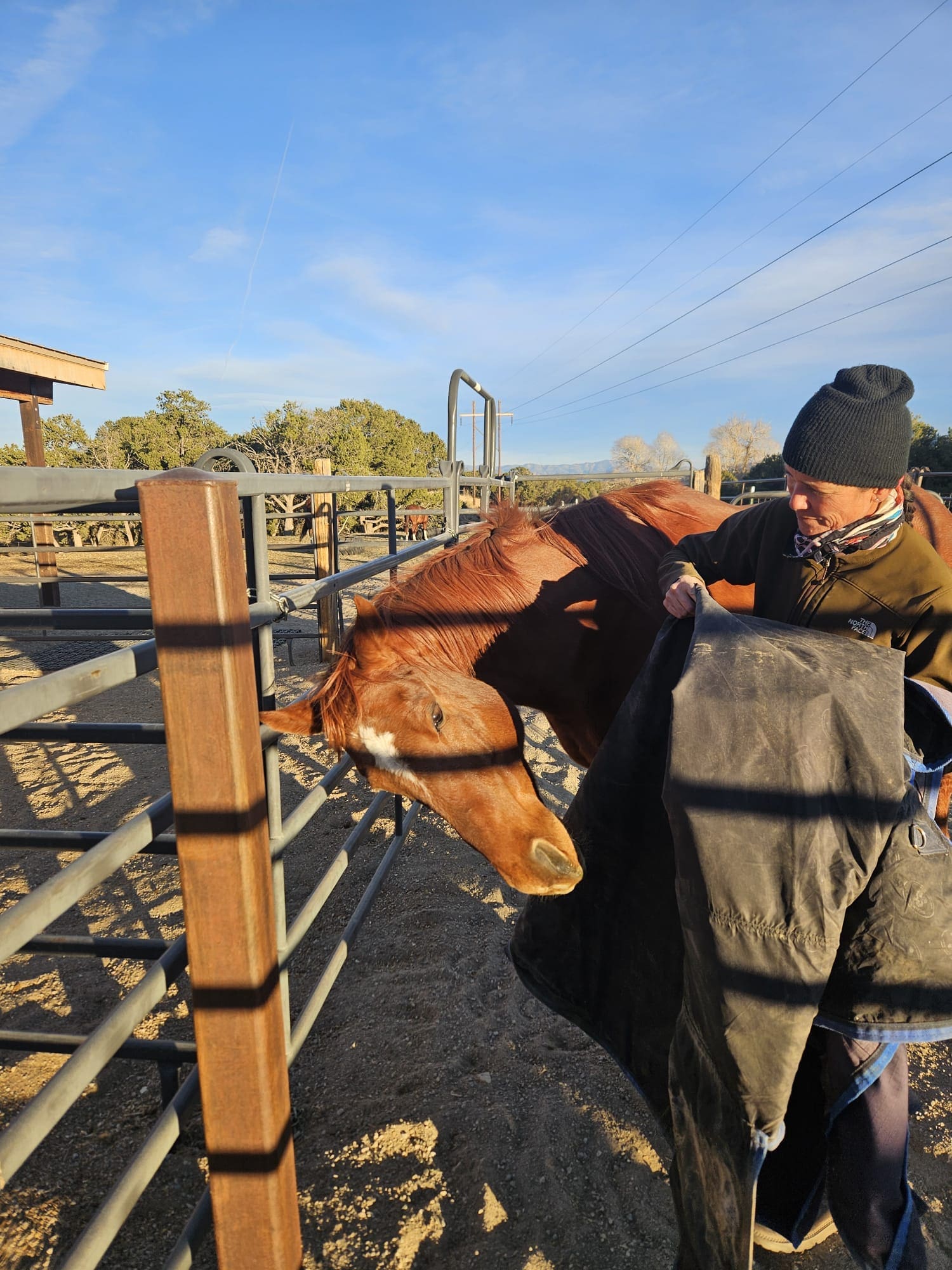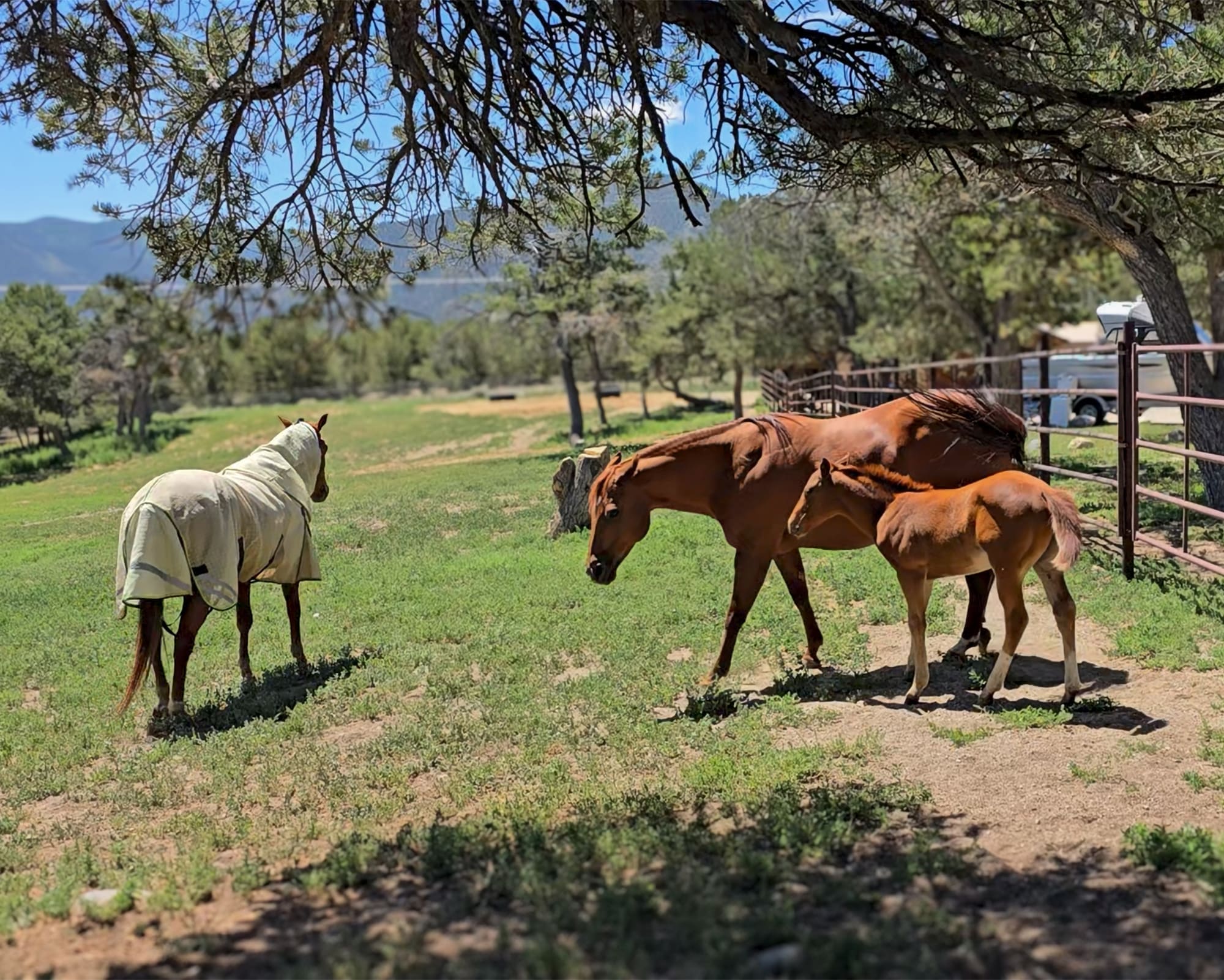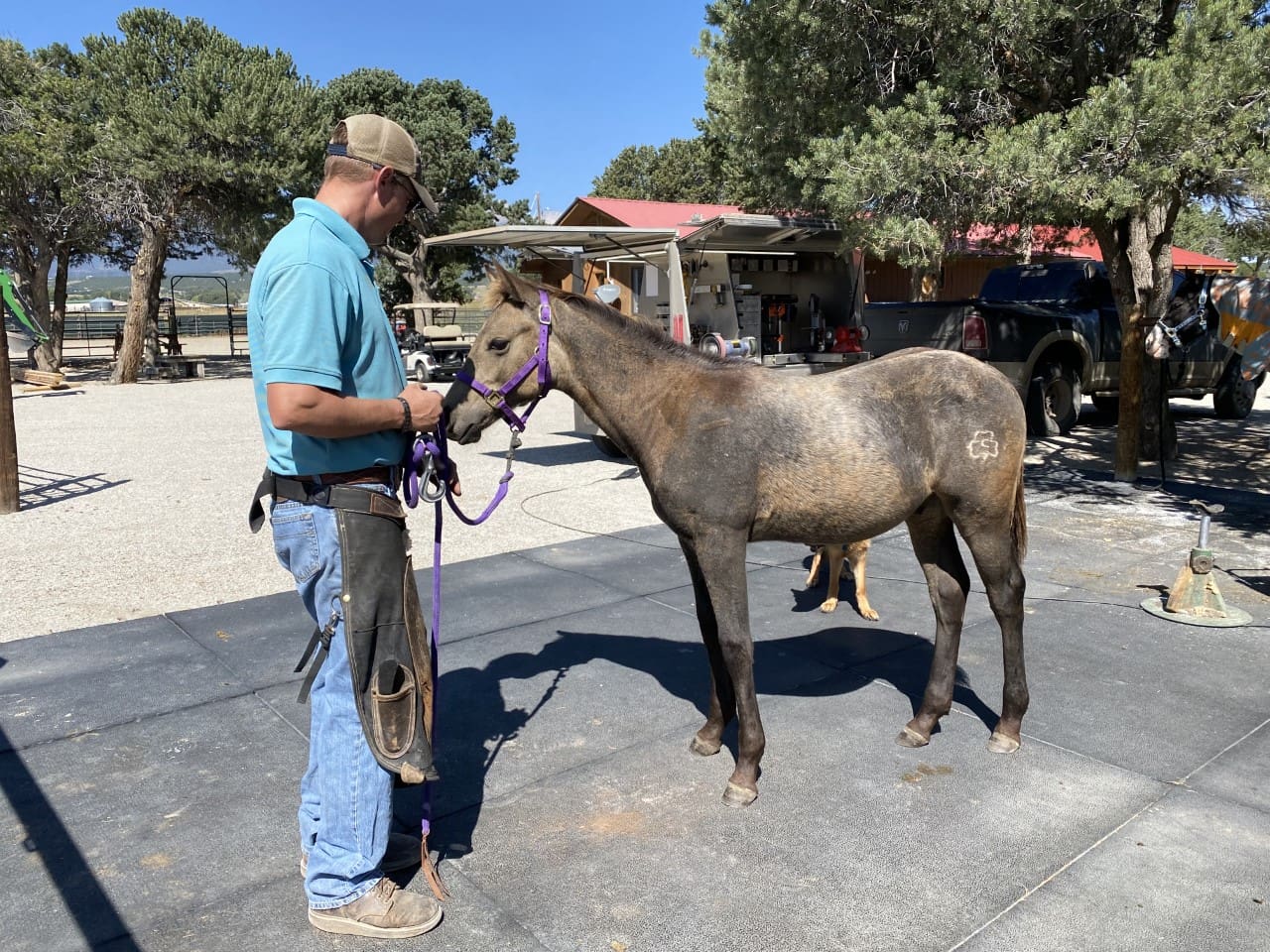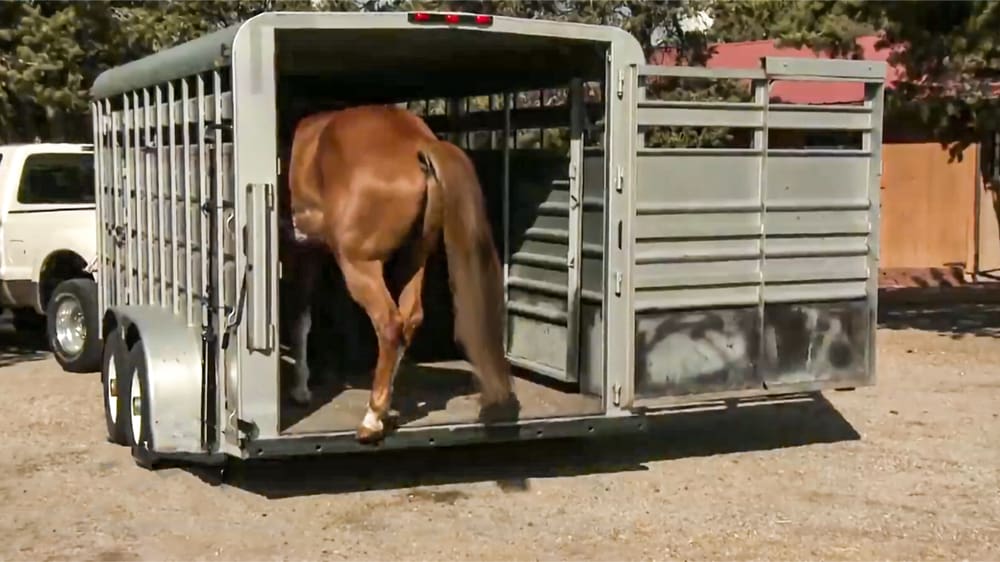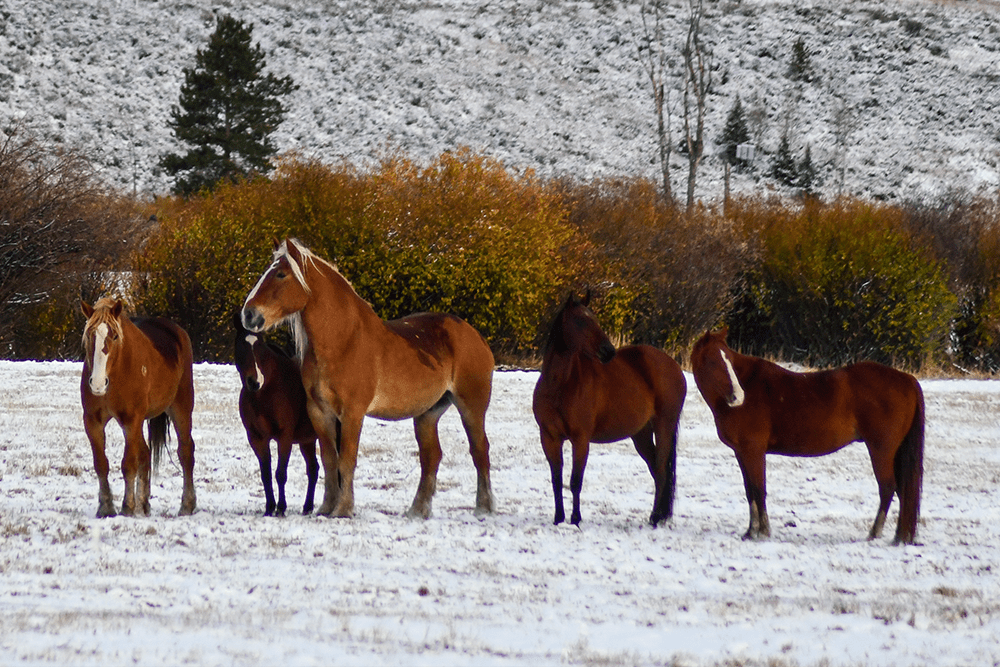
Things change fast up here in the mountains in early fall. The beginning of fall still feels like summer, but by the end all the leaves will have fallen and the mountains will be capped with snow. Up here in the Rocky Mountains, we take winter seriously and getting the barn and the horses ready for winter is no small task.
In spite of all the technological advances in weather forecasting, the Farmer’s Almanac remains one of the most reliable sources for predicting weather over the long run. This year, according to the Almanac, we are expecting “piercing cold and normal snowfall.” Great–all the cold and not enough snow. Our neck of the woods is still recovering from drought; we wish it read “normal temperatures and overwhelming amounts of snow.”
As fall approaches, I turn my attention to getting the horses and barn ready for winter. There’s lots to do from bringing in 24 tons of hay to winterizing our water system to preparing for winter riding. Winter comes early here in the Rocky Mountains at 8,000 feet of altitude: It’s best to be ready early and not get caught with your hoses frozen.
When people hear that I live in the high mountains of Colorado, they often ask, “How do the horses cope in the winter?” The truth is that horses have proven themselves to be highly adaptable to just about any environment. Our winters are long, with lots of snow and below zero temps. The horses do just fine but it is a lot of work to get prepared for winter and to keep our barn functioning in the cold.
I buy my hay once a year in early fall. I like to have at least an entire year’s worth of hay in the stack and securely covered with heavy-duty hay tarps. Over the last 30 years, I’ve found early fall to be the best time to buy hay–the best quality hay is in the stack and has had plenty of time to cure (buying hay right out of the field can be a risk); the supply is high in early fall and the prices most stable. I buy primarily grass hay, and around here there is only one cutting and it comes late in the summer.
Budgeting hay is easy: I’ve used the same formula for several decades and it’s never proved wrong. I buy 1/3 ton per horse per month. Right now we have six horses, so that’s two tons per month times 12 months equals 24 tons per year. Pricing hay by the ton is the most reliable method as cost per bale varies greatly with the type of hay and the size of the bale, which could be anything from 60 pounds to 600. Even if I am forced to buy by the bale, I always calculate the cost per ton. With small bales, there are roughly 28-30 bales per ton. Before you can calculate cost or the quantity you need to buy, you would at least have to know how much the average bale weighs.
Most horses do best on straight grass hay, although alfalfa can be useful as a supplement for youngsters and pregnant or lactating mares. The most important part of any horse’s diet is forage, and I prefer my horses to eat a simple and healthy diet of lots of high-quality, low-protein grass hay and a few oats as needed (mostly the oats are to carry the supplements we give them for their joints, their hair coats and hooves, although a couple of our horses need more calories and so get more oats).
On cold winter nights, we give them extra hay so they can munch all night long to keep warm. My budget of 1/3 ton per horse per month gives us plenty of hay to give extra on the coldest nights and accounts for a small amount of spoilage, which will invariably happen if your hay is not stored indoors.
I like my horses coming into winter a little on the fat side and then trimming up over the winter. This is the natural order for horses, and they seem to do best when their condition is consistent with what they would endure in the wild (fat in the summer and lean in the winter). So I don’t worry if the fat ones lose a little weight over the winter and I know that either the new green grass or an increase in their hay ration in the spring will help encourage shedding.
Most horses do just fine in our climate being outdoors and un-blanketed. They do need a windbreak, and generally when it is snowing hard the horses are happy to be inside the barn. Our horses are kept in individual stalls with runs at night and turned out in group paddocks during the day. This is the best of both worlds since at night we can better individualized their rations and during the day they can romp and socialize. If it is below freezing or very stormy, we lock the horses inside and close up the barn tight so their body heat is trapped inside to keep them a little warmer.
We do keep some horses blanketed during the winter–either because they are geriatric or because they are staying in training through the winter and will be ridden indoors. In the case of the seniors, they have such low body fat and it is difficult for them to get all the calories they need so the blankets help a lot. My performance horses are kept blanketed to keep their hair coats down to a minimum so they don’t end up wringing wet in sweat every time we ride.
Early fall is the time that we get all the blankets out, make sure they have been washed and repaired as needed and check to see if we have the right size and weight for all the horses that need them. We make sure they are fitted and labeled with each horse’s name. Since we have pretty harsh winters here, we use an “arctic weight” blanket for the performance horses. I also like a blanket that is waterproof and windproof since they may be outside in bad weather at times. I prefer “turtle necks” for the same reasons. Over the decades, I have discovered that it pays to buy the highest quality winter blankets. In the long run you’ll save money because they last for years instead of for weeks.
We also have to tackle the facility and get it ready for the winter. I always check my indoor arena this time of year to make sure the footing is good and no repairs are needed. We use Arena Rx to keep our indoor arena dust-free, and it occasionally needs an additional application. It’s well worth the money for both my horse’s health and my own to keep the arena dust-free.
Coming into winter I like to make sure my saddle pads are clean. We spend some extra time cleaning and conditioning the leather tack. I am fortunate to have a heated tack room, which is much easier on the leather. If your tack room is not heated, you may need to protect certain drugs, medications and supplies like fly spray from freezing (a little dormitory sized refrigerator works great for this).
Once winter sets in for good and we can no longer ride outdoors, we move all our tack to the unheated indoor arena so we can groom and tack out of the elements. If you don’t have a warm place to keep your tack, it’s not a bad idea to move it into your house or garage if you can. Get yourself a pretty wooden saddle rack and make it part of your decor! Keeping your bridles inside will keep the bit from freezing your horse’s tongue.
With sub-zero temperatures for weeks on end, water is always big problem in the winter. Hoses and attachments have to be drained and put away; the automatic waterers have to be checked and re-checked to make sure the heaters are working and our outdoor wash rack has to be put to bed. We hang heated water buckets in the stalls that don’t have automatic waterers.
Additionally, I like to make a corner-to-corner inspection of the barn, the barn yard and surrounding areas to make sure little odds and ends are put away–the rake someone left out, the pliers lying in the corner, the weed eater, etc. There’s nothing worse than getting an early snow storm and burying all that stuff that somehow got left out over the summer!No doubt, after all this preparation, we’ll be sure to have an Indian summer. Bring it on! By the end of early fall, winter will be ready to pounce at any time here in Colorado, and I hate to be caught off-guard. Keeping horses in the winter in cold climates can be a real challenge, but being prepared will make it much easier to endure–for both you and your horses!
Enjoy the ride,
Julie
Check out Julie’s Website: HERE
